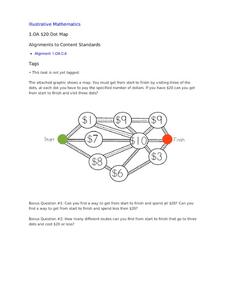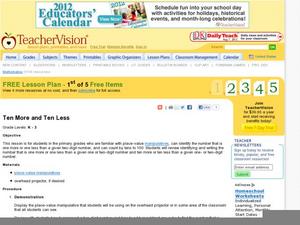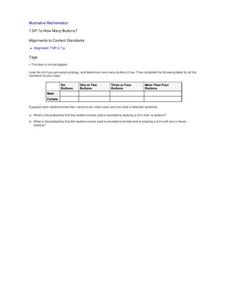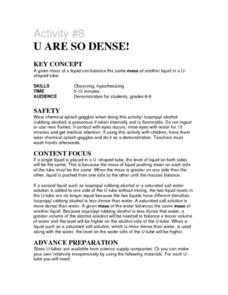Illustrative Mathematics
“One More” Concentration
Help your primary learners develop an understanding of the concept of one more and one less using two sets of number cards. The first set of cards, all in one color, is the "one less" deck. The second set, again all in one specific...
Illustrative Mathematics
$20 Dot Map
Challenge the addition skills of young learners with this open-ended math problem. The task is simple, get from start to finish by connecting a series of three numbers. The trick is that the sum of the numbers must be less than...
Curated OER
Number Rods
Working in a math center or an "I finished early" work station, young mathematicians will match in sequence pre-set-up rods of unifix cubes to numbers on a number line. To help differentiate tens from ones, use different colors to...
Curated OER
Ten More and Ten Less
Get learners to analyze two-digit numbers based on place value, and use manipulatives to add and subtract both 1 and 10. A place value chart is available, and you can project it during guided practice. Through visualizing...
National Wildlife Federation
Wherefore Art Thou, Albedo?
In the sixth instructional activity in a series of 21, scholars use NASA data to graph and interpret albedo seasonally and over the course of multiple years. This allows learners to compare albedo trends to changes in sea ice with...
Curated OER
Make a Ten
Youngsters mentally perform calculations involving addition and subtraction. They solve various addition and subtraction word problems using mental math and counters, write their own number stories, and solve various examples...
Curated OER
Relations and Graphs
Here is a simple, yet clever lesson on how to teach the important concepts of greater than, less than, and equal to. Pupils write their names down on grid paper - one letter per box. They compare their names and find a name that is...
Curated OER
Practicing Addition Strategies
For this math worksheet, students add the numbers 5 and 6 using two different methods. They first count up from six. Students say seven, eight, nine, ten, eleven to get to their answer. The second method is to use doubles. They think...
Curated OER
Place Value: A Place for Apples
Second graders explore number values by completing math worksheets. For this place value lesson, 2nd graders identify the use of decimals in numbers and read a book about math called Apple Pigs. Students create number charts based on the...
Curated OER
Button Math
Use buttons, cards, and dice to perform simple math problems! This inventive lesson should be quite engaging for young learners. Kindergarteners use buttons to help them understand the concepts of greater than, less than, and equal to.
Curated OER
How Many Buttons
Help learners explore the concepts of more than, less than, and equal to. They participate in a button attribute activity, play a game using buttons and a die, draw the sets of buttons in their journal, and play button bingo.
Curated OER
Rice Math Problems
Third graders practice solving math equations using rice as their subject. They translate situations involving rice into math equations in order to solve them properly. They also discover and practice using math vocabulary terms...
Curated OER
ALARA
This activity sheet posts a chart of the common radiation sources in our everyday lives. Chemistry scholars use it to analyze their own radiation exposure using rem (Roentgen equivalent for man) units. This simple assignment increases...
Curated OER
Multiplying in Columns, Standard Way
In this multiplying and carrying worksheet, students compare the standard algorithm with the multiplying in parts method and their examples, choose which method to use, and find the products. Students solve twenty problems.
Curated OER
Esters as Food Flavorings
Students produce esters in the laboratory by combining different carboxylic acids with different alcohol. In this esterification lesson plan, students experiment with 3 carboxylic acids and 3 alcohols to produce 3 esters with fruit like...
Curated OER
Activity #8 U Are So Dense!
Students watch as the teacher demonstrates: if a single liquid is placed in a U-shaped tube, the level of liquid on both sides are the same. When the mass is greater on one side than the other, liquid is pushed from one side to the...
Curated OER
Ridgerunner
Young scholars jog at the beginning of the class while learning about the Appalachian Trail. They integrate math into the lesson by adding up how many miles they have run, and comparing it to distances on a real trail map.
Curated OER
Hot Friction
Sixth graders use small electronic devices known as thermistors to measure the temperature beneath an object such as a coffee cup as it slides across a surface. By choosing different surfaces, 6th graders can compare in a quantitative...
Curated OER
Density
Young scholars explore the meaning of density. In this density lesson, students use interactive whiteboards to review definitions regarding density and compare the density of selected objects.
Curated OER
Melt in Your Mouth Subtraction
Students engage in a lesson which involves role-play and the use of manipulatives to solve subtraction problems. After a lecture/demo, students utilize a worksheet imbedded in this plan to gain subtraction practice. They get to eat the...
Curated OER
Aluminum Altruism
Students explore the value of recycling. They consider the importance of giving back to their school community. They calculate their earnings using multiplication and addition.
Curated OER
Addition and Subtraction of Signed Numbers
Young scholars explore the concept of adding and subtracting using positive and negative numbers. For this addition and subtraction of signed numbers lesson, students use pennies to represent positive and negative numbers. Young scholars...
Curated OER
Melting Ice
Students observe the melting of ice and explore the basic physical changes that occur. They gain information of how different substances change the rate of melting. Students discuss the properties of water and ice, the definition of...
Cornell University
Bridge Building
Bridge the gaps in your knowledge of bridges. Individuals learn about bridge types by building models. The activity introduces beam bridges, arch bridges, truss bridges, and suspension bridges.























